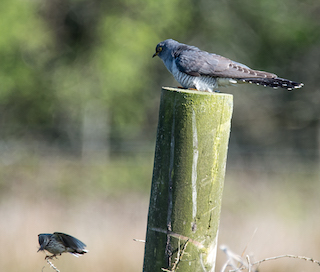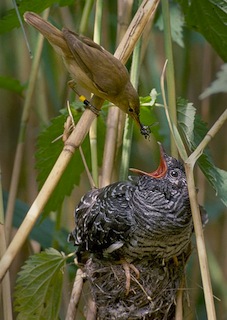Cuckoos migrate back to the UK in the spring.
Photo: Aviceda (Wikimedia Commons)
Scientific name: Cuculus canorus
Cornish name: Kog
Conservation status: UK Birds of Conservation Concern, Red; IUCN Red List, Least Concern
What to look for:
- Colouring and appearance: Slate-grey back, head and wings; underparts are white with dark bars. The body is slender, and the pointed wings are clearly seen in flight. Males and females are similar, but there is a rufous form of the female.
- Size: Length 33 cm, wingspan 58 cm.
- Where: Across the UK (although more frequent in the south and central regions), from March/April until July/August. Will live in a variety of habitats.
- Call: http://www.xeno-canto.org/37447
- Similar species: From a distance, it could be confused with a Sparrowhawk.
 It’s the quintessential sound of summer, isn’t it? The two repeated notes of a Cuckoo calling in the distance across the fields and hedges are what, for many of us, conjure up the lazy, hazy days of our warmest season. In fact, these migrants to our shores from Africa arrive in the spring, and everyone wants to hear the first one of the year.
It’s the quintessential sound of summer, isn’t it? The two repeated notes of a Cuckoo calling in the distance across the fields and hedges are what, for many of us, conjure up the lazy, hazy days of our warmest season. In fact, these migrants to our shores from Africa arrive in the spring, and everyone wants to hear the first one of the year.
The famous call belongs to the male Cuckoo, but the honour of its other well-known attribute goes to the female. The Cuckoo is of course famous for being a parasite of other birds. More specifically, it is a brood parasite: the female pushes out an egg from the host birds’ nest, quickly lays her single egg as a replacement, and leaves the ‘foster’ parents to get on with it. The female Cuckoo can repeat this several times in a year, laying a single egg in each parasitised nest. The Cuckoo chick hatches in just under two weeks, often ahead of its foster siblings. It pushes the other eggs and any chicks out of the nest, and the parent birds are left to valiantly feed the growing giant in their home.
 Reed Warblers, Dunnocks and Meadow Pipits are particular targets of this behaviour: sub-populations of Cuckoos favour different hosts, and have evolved so that their eggs resemble their chosen species. The picture to the left shows a Reed Warbler attempting to feed a Cuckoo chick.
Reed Warblers, Dunnocks and Meadow Pipits are particular targets of this behaviour: sub-populations of Cuckoos favour different hosts, and have evolved so that their eggs resemble their chosen species. The picture to the left shows a Reed Warbler attempting to feed a Cuckoo chick.
Despite its broad habitat preferences and wide diet of insects, caterpillars, spiders and worms, the Cuckoo is declining in the UK. This is thought to be because of declines in the host species.
Did you know…?
…The female Cuckoo lays her eggs in nests of the same species as those in which she herself hatched and fledged.
…In many cultures, the first notes of the Cuckoo heard each year are considered to bring good fortune.
More information and references:
Svensson, L., Mullarney, K., Zetterstrom, D.,1986. Collins Bird Guide, second edition (translated by Christie, D., Svensson, L.). HarperCollins, London.
Published: April 2015 (updated May 2018)
Author: Amanda Scott
Photos:
Top (icon): By Aviceda [CC BY-SA 3.0], from Wikimedia Commons
Upper this page: Dougy Wright, taken at Windmill Farm in May 2018
Lower this page: Per Harald Olsen (Own work) [GFDL or CC-BY-SA-3.0]
